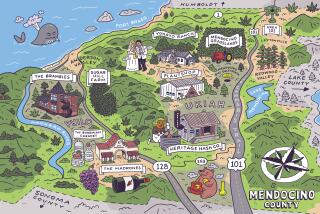Gilroy Garlic Festival Exudes Sweet Smell of Success, Imitation
- Share via
GILROY, Calif. — Never mind that one of the star attractions is a frozen concoction of milk, sugar and granulated garlic.
Forget that traffic on the only freeway through town is backed up for miles or that it’s so hot--95 degrees and rising--that the endless clouds of dust are starting to stick.
This is the Gilroy Garlic Festival.
And Marilyn Novara, an employee of Gilroy Foods, one of the country’s leading garlic processors, knows exactly why she’s cooped up in a sauna-like tent serving garlic ice cream to the masses.
“Garlic,” she says, “is gold.”
The festival, which started in 1979, has earned Gilroy the title of Garlic Capital of the World. But these festivals have come to mean far more than bragging rights. The millions of dollars they generate for charity and local business have become enough for many small towns across the country to put up with the inconvenience of being overrun for a few days.
“You go anywhere in this country and they’ve heard of the Gilroy Garlic Festival,” says Bruce Skinner, president of the International Festival and Events Assn. Skinner’s group has 2,400 member festivals worldwide, including the Kentucky Derby, Taste of Chicago and the Tournament of Roses in Pasadena.
But it’s the little towns that are most challenged to make room for only a few days out of the year, installing rows of portable potties and banks of pay phones.
Consider Gilroy, a bedroom and farming community just south of San Jose that has sometimes attracted more than 150,000 people--about four times its population--during the three-day Garlic Festival.
Numbers like those seem to be a requirement for any town that wants to hang the “capital” title on its city limits sign.
Traverse City, Mich., a town of 17,000 and the world’s self-proclaimed Cherry Capital, has more than half a million people on its doorstep during the eight-day National Cherry Festival in July.
And, in August, as many as 350,000 bikers have invaded Sturgis, S.D., population 5,000, for the annual Sturgis Rally and Races. The world-renowned event turns the usually sleepy farm town into hog heaven--of the biker variety.
“If you’re Jewish, you make a pilgrimage to Israel . . . . ,” says Harley-Davidson rider Chip Rohrig of Pleasanton, Calif. “If you ride a Harley, you make a pilgrimage to Sturgis.”
It gets so busy in Sturgis that some business owners shut down for the week and rent out their space to peddlers of motorcycle-related products.
Then they pull up a chair for the show.
“Last year, I swear I saw a woman, 300 pounds, on the back of a Harley with pasties and a G-string,” says Janet Harmon, a hairstylist at the Sheer Xpressions salon in Sturgis. “I mean, you never know what you’re going to see. . . . You don’t need cable for a week.”
Harmon and the majority of folks in Sturgis and other small towns generally give their festivals rave reviews. But not everyone is happy.
In Traverse City, a Lake Michigan resort town that continues to struggle with development issues beyond the Cherry Festival, a bumper sticker carries this message for tourists:
The parade’s over. Go home.
“The local people have just sort of turned it over to the tourists. It’s not our festival anymore,” says Ann Rogers, a Traverse City resident whose late husband, Joe, ran a campaign in 1993 aimed at shortening the Cherry Festival to reduce its size.
His ballot measure, however, failed by a 2-to-1 margin.
“I like it big,” says Rick Korndorfer, owner of an office supply store on Traverse City’s main street. “I do get tired of people coming in to use the bathroom all the time. But I like the town being filled up.
“It puts us on the map.”
And then there’s the money the festivals generate, which some say has a big effect on the locals’ tolerance for the onslaught.
“Whoever’s making the money likes it,” Harmon, the Sturgis hairstylist, says of the biker rally. “And whoever isn’t, doesn’t.”
In Gilroy, the Garlic Festival has brought in more than $5 million for charities since it began and millions more for local businesses. It’s been so lucrative that surrounding towns are attempting to get a piece of the action.
Nearby Castroville now celebrates the artichoke. Stockton has the asparagus; Watsonville, strawberries; and Morgan Hill, the Mushroom Mardi Gras.
The fungus fest has some Gilroy residents scoffing.
“It’s OK, I guess. But not really,” Gilroy resident Edesa Forslan says.
Her biggest complaint? “It’s too small.”
More to Read
Eat your way across L.A.
Get our weekly Tasting Notes newsletter for reviews, news and more.
You may occasionally receive promotional content from the Los Angeles Times.









